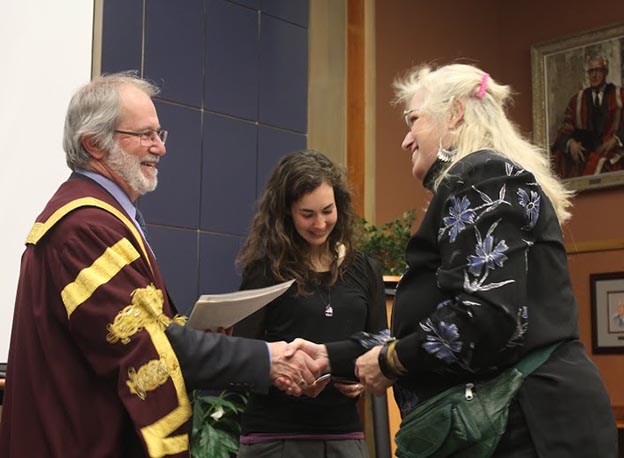A university program that offers Discovery for everyone

President Patrick Deane, left, in his ceremonial robes, attended this year's Discovery Program graduation ceremony, held Dec. 14 on campus. The program offers a no-cost, university-style course to adults who have missed out on the chance for a post-secondary education, often because of economic, social, medical and other barriers.
It’s hard to say who learns most from McMaster’s Discovery Program, wrapping up its third annual session with a graduation program for 20 students on Saturday, Dec. 14.
The program, which has grown in size and reputation since its inception, offers a no-cost, university-style course to adults who have missed out on the chance for a post-secondary education, often because of economic, social, medical and other barriers.
While the students are especially eager learners, members of the team that organizes and delivers the program say they get at least as much of an education.
The Discovery Program’s primary goals are to open access to the university experience and to help the students to see Hamilton in new ways. This year’s class has included 20 students, up from 15 in 2011 and 2012. They represent a broad range of ages and backgrounds.
The program is supported by partners that include the Office of the President, the City of Hamilton and the Hamilton Community Foundation.
Students are fully supported throughout the four-hour Saturday sessions, including lunch, and academic advice from the instructor, co-ordinator and a team of student and community volunteers.
While the Discovery students are learning the course content, they are also learning more about themselves and their potential, the organizers say. They work on assignments that interpret their new knowledge.
This year’s class, Plagues and the People of Hamilton, has been building toward a graduation ceremony featuring such projects as a map of Hamilton’s experiences with plagues, a video on H1N1, and a mandala — a layered and narrative collection of symbols — connected to plagues.
The team that presents the course invariably emerges feeling inspired and enriched by the sharing of knowledge and participating in a meaningful common experience with the students, and this year is no exception.
Anthropology professor Ann Herring taught the recent session on plagues, reflecting her own research specialization. The class visited such locations as the municipal cemetery on York Boulevard, where victims of the 1918 influenza pandemic are buried, and the nearby memorial to cholera victims who died in 1854-55. They toured the Hamilton Museum of Steam & Technology to learn about public sanitation’s role in stemming the spread of infectious diseases, and the Sanitorium to learn about tuberculosis.
Herring says she learned at least as much as the students did.
“It’s been a very profound experience for me,” she says. “I’m very impressed by the students. It’s not just a matter of us delivering something to them. It’s definitely a two-way experience.”
Co-ordinator Jeanette Eby, who has been with the program since its inception, says the students are learning much more than the course content.
“They are learning about the power of knowledge and sharing knowledge,” she says.
The third round of the program has been guided by the participation of graduates from 2011 and 2012, who make up half the advisory committee for the Discovery Program.
The first years of classes took place at the Hamilton Public Library’s Central branch to make the program more accessible, but the graduates made it clear that students would rather be on campus, so that’s where they have been learning for the past 12 weeks.
Former students of the program have now also formed a Level II course, where they have been informally shadowing the plague program, in further testimony to Discovery’s effectiveness.

